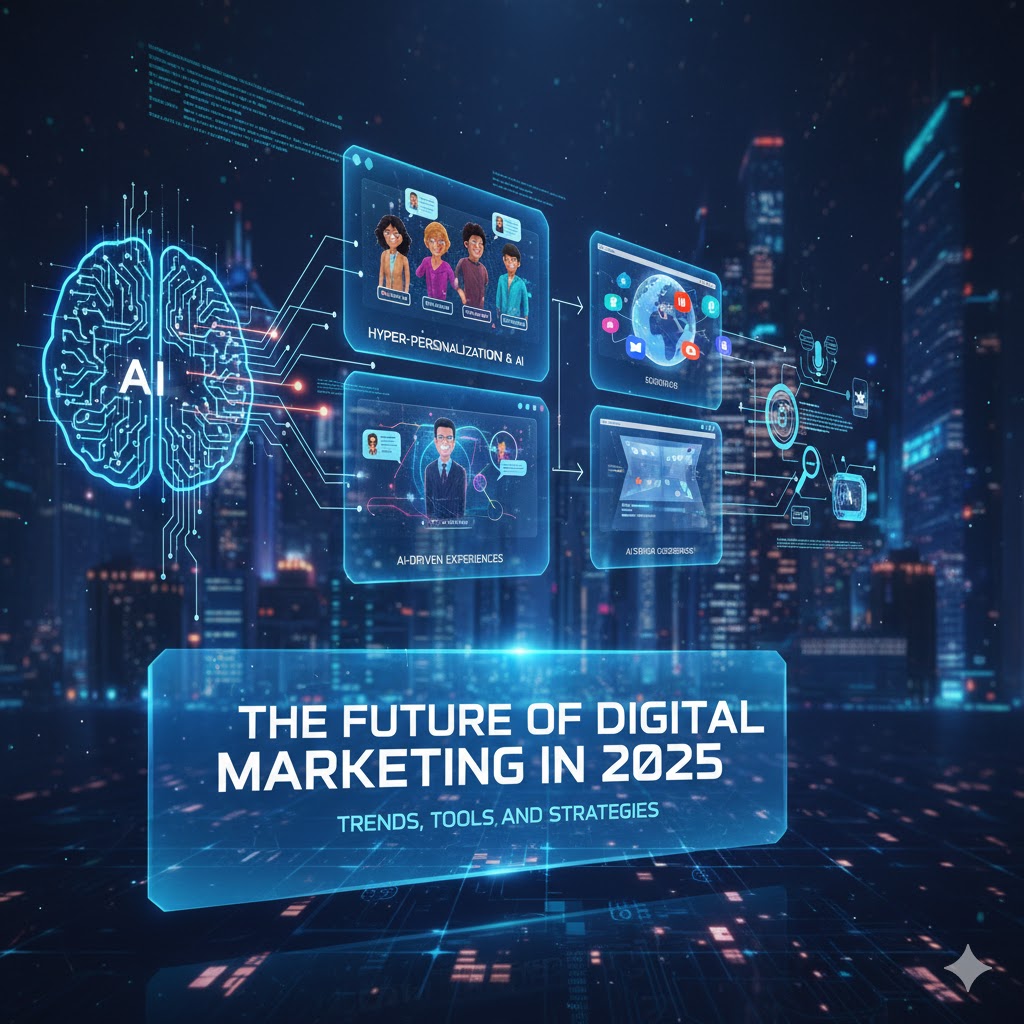
The Future of Digital Marketing in 2025: Trends, Tools, and Strategies
Introduction
Imagine scrolling through your phone and discovering that your ad was created, targeted, and optimized by an AI while you slept. That may sound like a sci-fi scene, but in 2025 it's closer to reality for many marketers than ever before. As a student interested in marketing, business, or communications, understanding what’s around the corner isn’t just interesting it's essential. The digital marketing landscape is evolving at such a pace that today's “cutting-edge” is tomorrow’s background noise.
In this article, we’ll unpack how digital marketing is changing in 2025 from emerging trends and tools to practical strategies you can learn now. We’ll dig into generative AI, voice and visual search, data privacy, omnichannel experiences, and more. For each topic, you’ll get real-world examples, expert insights, and actionable advice you can apply (even if you’re still in school). Think of this as your roadmap to becoming future-ready in the world of digital marketing.
Why 2025 Matters: The Big Picture
Before diving into specifics, let’s zoom out a bit. According to Deloitte Digital’s “Marketing Trends of 2025” report, three core shifts stand out: building seamless omnichannel experiences; embracing automation and generative AI; and transforming privacy into opportunity via first-party data. Deloitte Likewise, the Digital Marketing Institute highlights how in 2025 marketers must refine AI skills, invest in soft skills and adapt to changing search behaviours. Digital Marketing Institute What this means for you as a learner: the rules of engagement are shifting—and the earlier you understand them, the better prepared you’ll be.
1. Generative AI & Automation: The Engine of Tomorrow
Why it matters
The explosion of generative AI tools is altering how content, ads, and campaigns are created. For example, according to Exploding Topics, “No new platform or technology is impacting the marketing space in 2025 more than generative AI.” Similarly, the study on LLMs (large language models) highlights how they drive personalization, real-time insights, and content automation.
Common problems
· Creating scalable content without losing human nuance
· Managing large volumes of data and separating signal from noise
· Ensuring AI-generated artifacts maintain brand voice, compliance and ethics
Insight
Generative AI doesn’t replace human creativity it amplifies it. For example, a mid-sized brand might use AI to draft email sequences, but marketing humans still craft the tone, choose imagery and define strategy. The key insight: use AI to augment, not replace.
Actionable tips
· Experiment: Try an AI tool (e.g., content generation, creative design) and measure time saved or quality gained.
· Build governance: Develop simple policies around what AI can and cannot do (especially with brand messages).
· Learn the data skills: Understand how to interpret AI output, check for bias, and refine prompts.
· Human in the loop: Always review AI work for tone, context and accuracy.
2. Search Everywhere: Voice, Visual & Platform Convergence
Why it matters
Search is no longer just on Google’s desktop interface. The landscape now includes voice queries, visual image search, and platform-based search (e.g., TikTok, Instagram, YouTube). According to TheeDigital, in 2025 voice search and visual search are key trends. The Kantar report emphasises that “the voyage to total video” and platform convergence are central for 2025.
Common problems
· Marketers still optimizing only for traditional keywords and web search
· Voice queries often more conversational, making traditional SEO less effective
· Visual search requires imagery, metatags, structured data and new tactics
Insight
The shift: Think less “type a keyword” and more “ask a question”, “show a photo”, or “watch a clip then buy”. For a student entering this field, being comfortable with multi-modal search (spoken, pictured, video) is a major advantage.
Actionable tips
· Voice search: Use natural language in your content (e.g., “Hey Siri/Google, how do I…”).
· Visual search: Ensure imagery on websites is tagged, high quality, descriptive alt-text and schema markup.
· Platform search: If marketing on TikTok or Instagram, optimise profile, hashtags and captions to reflect search intent within those apps.
· Integrate: Don’t treat each channel in isolation—create content that can be repurposed across voice, visual and platform search.
3. Omnichannel Experiences & Phygital Strategies
Why it matters
In 2025, the divide between physical and digital is shrinking. Deloitte notes “Connect and Captivate Omnichannel Experiences” as a key trend. The term “phygital” (physical+digital) is now being used more frequently.
Common problems
· Brands running channels (web, store, app, social) separately and not coordinated
· Inconsistent brand experience across channels
· Data silos: insights in-store not feeding digital and vice-versa
Insight
Winning brands will stitch together all customer touch-points so that the user journey flows seamlessly—from ad on mobile → store visit → app interaction → purchase. For students, understanding customer journeys across channels is a key differentiator.
Actionable tips
· Map the journey: Choose a sample customer persona and map how they might travel across channels (online research → social → store → app).
· Unified metrics: Propose or track one key metric that spans channels (e.g., total engagement minutes rather than just clicks).
· Cross-channel creative: Create an idea that can run in-store signage, social, mobile, and web without losing coherence.
· Use tech: Leverage tools like CRM systems or CDPs (Customer Data Platforms) to pull data from multiple touchpoints.
4. First-Party Data & Privacy-Centric Marketing
Why it matters
Cookies are phasing out, consumer expectations around data privacy are rising, and regulatory frameworks are tightening. Deloitte identifies “Transform Privacy into Opportunity with First-Party Data” as trend #3 for 2025. Meanwhile, trust is now a currency in marketing—brands that misuse or neglect privacy risk backlash.
Common problems
· Relying heavily on third-party cookies and data sources that are disappearing
· Collecting data without transparency or clear value for the user
· Failing to act on the data you own
Insight
First-party data (data collected directly from users) is gold but only if you treat it ethically, use it strategically and respect privacy. The winning mindset: “what’s in it for the customer?” not just “what can I extract?”.
Actionable tips
· Audit your data: What data are you collecting? Why? Is it transparent to users?
· Value exchange: Provide something meaningful in return (discounts, insights, improved experience) for user consent.
· Segmentation and activation: Don’t just store data—use it (e.g., segment loyal users, personalize offers).
· Stay compliant: Be aware of regulations (e.g., GDPR, CCPA) and ensure your practices meet legal/ethical standards.
5. Hyper-Personalisation & Real-Time Engagement
Why it matters
Consumers expect experiences tailored to them. According to TheeDigital, 73% of consumers demand personalization. And GWI highlights how Gen Z prioritises brands offering customised products. Personalisation at scale is no longer optional.
Common problems
· Personalisation that feels creepy rather than helpful
· Lack of dynamic content or segmentation capability
· Using basic data (name only) instead of behavioural insights
Insight
Effective personalisation blends data + context + timeliness. In other words: knowing who the user is, where they are in the customer journey, and what they need right now.
Actionable tips
· Micro-segments: Go beyond “male/female” or “age 18-34” – segment by behaviour, interest, stage.
· Dynamic content: Use tools that replace parts of content (e.g., homepage banner, email) based on segment.
· Real-time triggers: Use events like “opened app twice this week” or “added item but didn’t buy” to send unique messages.
· Measure impact: Track uplift in conversion, engagement, retention—not just surface metrics.
6. Short-Form Video, Social Commerce & Creator-Led Strategies
Why it matters
The rise of social platforms as commerce engines and attention hubs means video and creators matter more than ever. HubSpot’s “State of Marketing Report” signals that short-form video and influencer/creator collaborations deliver high ROI. Meanwhile, TheeDigital emphasises social commerce and platform convergence as key.
Common problems
· Treating video as an afterthought
· Investing in creators without strategy or clear metrics
· Ignoring social commerce potential (shops inside apps)
Insight
If you’re a student learning marketing: think of yourself also as a creator. Many brands now partner with micro-influencers (smaller audiences but higher trust). Content must be snackable, authentic and shoppable.
Actionable tips
· Create your own short-form video (15–30 sec) about a product/service, test feeling and flow.
· Partner-style experiment: If you have a small social platform, try reviewing a product and track engagement.
· Enable commerce: If on Instagram or TikTok, explore how to tag products or enable checkout inside the app.
· Metrics matter: Track engagement, video completion rate, click-through to purchase—not just “likes”.
7. Ethical, Inclusive & Sustainable Marketing
Why it matters
Consumers increasingly care who a brand is, what it stands for, and how it behaves not just what it sells. GWI highlights sustainability and brand values among 2025’s top trends. And El País reports how transparency, interactivity and ethical marketing play huge roles in 2025.
Common problems
· Marketing campaigns that ignore inclusivity (culture, accessibility, diversity)
· Sustainability as a “side note” instead of integrated into strategy
· Ignoring data ethics and transparent messaging
Insight
Marketing isn’t just about pushing messages it’s about building relationships grounded in trust. For young students, being aware of ethical implications now will make you a stronger marketer later.
Actionable tips
· Inclusive content: Ensure your imagery, language and audience targeting reflect diversity.
· Sustainability messaging: If you claim sustainable practices, back them with data or stories.
· Transparent data use: Clearly communicate how you’re using consumer data and why.
· Accessibility: For content, include alt-text, captions on videos, mobile-friendly design.
8. Skills & Teams: Future-Ready Marketers
Why it matters
Trends and technologies shift fast but the human skills behind them matter even more. Deloitte’s list for 2025 marketing includes “Supercharge Teams with Future-Ready Skills”. According to Digital Marketing Institute, 2025 marks growing value of soft skills and refining AI awareness.
Common problems
· Being technically literate but lacking strategic or creativity skills
· Focusing only on tools and forgetting storytelling, empathy and psychology
· Teams operating in silos (data, creative, tech) instead of integrated
Insight
As a student, your job isn’t just learning tools it’s developing critical thinking, storytelling, analytical ability and digital literacy. These human-first skills are what AI can’t replicate (at least not yet).
Actionable tips
· Work on a side project: Create a mini marketing campaign (online or hypothetical)—this builds both technical and creative muscle.
· Collaborate cross-discipline: Pair with someone in tech, data or design to experience teamwork.
· Learn analytics: Basic understanding of metrics (CTR, CPA, retention) matters.
· Stay curious: Subscribe to marketing trend newsletters, attend webinars, follow industry voices.
9. Strategy Integration & Measurement in 2025
Why it matters
All the trends above are interconnected but many fail because there’s no cohesive strategy or meaningful measurement. According to GWI, paid media still drives discovery (83% discover new brands via online ads) but the measurement must evolve. Meanwhile, traditional metrics are being challenged by new behaviours (less clicks, more engagement).
Common problems
· Chasing every shiny new trend without aligning to business goals
· Using outdated KPIs (e.g., impressions only)
· Viewing channels in isolation
Insight
The best strategies link insight → action → measurement: start with a clear objective, choose the right channel(s), execute with relevance, and pick metrics that tell the real story. In 2025, metrics like “time-in-experience”, “share of voice in generative AI responses”, or “visual search engagement” are beginning to matter.
Actionable tips
· Define 1-3 objectives: (e.g., increase student sign-ups by 20% in the next quarter)
· Select channels: Choose where your audience is (TikTok? Instagram? voice search?)
· Choose relevant KPIs: E.g., conversation rate, retention rate, cost per acquisition—not just clicks
· Review and iterate: Look at what worked, pull insights, pivot fast.
Conclusion
In 2025, digital marketing isn’t just about chasing the next gadget or platform it’s about understanding people, merging technology with empathy, and building trust. From generative AI and voice/visual search to omnichannel experiences, privacy-first data, and ethical marketing, the landscape is shifting dramatically. But for students such as yourself, this is an exciting time to jump in.
Remember these key takeaways:
· Embrace AI & automation but keep the human in the loop.
· Think “search everywhere” not just Google.
· Build experiences that span physical and digital channels.
· Treat data ethically and focus on first-party insights.
· Personalise meaningfully and measure what matters.
· Value storytelling, transparency and purpose.
· Develop human skills alongside technical ones.
You may be at the start of your journey but the tools, trends and opportunities are evolving fast. Stay curious, stay adaptable, and you’ll be well-positioned to lead in a future where digital marketing looks very different from what it did even five years ago.
Good luck your future in digital marketing awaits!
Frequently Asked Questions (FAQs)
Q1: What’s the biggest digital marketing trend in 2025?
The consensus points to generative AI and advanced automation as the top trend. In particular, how this technology enables personalised content and real-time optimisation.
Q2: Is SEO still important with all these new channels (voice, visual, social search)?
Yes but you need to adapt. SEO is still fundamental, but you now need to optimise for voice queries, image/visual search, in-app search, and even AI-generated overview answers rather than just traditional SERPs.
Q3: How should small businesses or students with limited budget approach these trends?
Start small: pick one or two trends relevant to your audience (e.g., short-form video + social commerce), test, learn, and scale. Focus on meaningful data (first-party), and partner with creators or micro-influencers for affordable impact.
Q4: With privacy regulations increasing, does data-driven marketing become harder?
It becomes different, not harder. You’ll rely more on first-party data and build more trust with your audience. That often means better engagement and loyalty, which in turn enhance performance.
Q5: What skills should I be developing as a marketing student to stay relevant in 2025?
Focus on a mix of:
· Digital literacy: tools, analytics, content platforms
· Storytelling & creativity: brand voice, messaging
· Data interpretation: metrics, segmentation, insight generation
· Critical thinking: ethics, inclusivity, strategy
· Adaptability: staying current with trends and new formats.
Tags :
No Tags












0 Comments